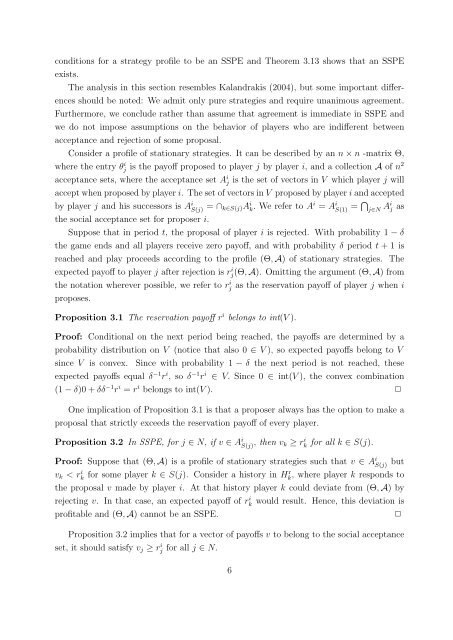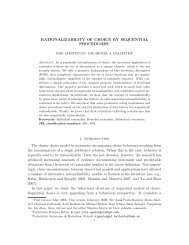Non-cooperative Support for the Asymmetric Nash Bargaining Solution
Non-cooperative Support for the Asymmetric Nash Bargaining Solution
Non-cooperative Support for the Asymmetric Nash Bargaining Solution
Create successful ePaper yourself
Turn your PDF publications into a flip-book with our unique Google optimized e-Paper software.
conditions <strong>for</strong> a strategy profile to be an SSPE and Theorem 3.13 shows that an SSPEexists.The analysis in this section resembles Kalandrakis (2004), but some important differencesshould be noted: We admit only pure strategies and require unanimous agreement.Fur<strong>the</strong>rmore, we conclude ra<strong>the</strong>r than assume that agreement is immediate in SSPE andwe do not impose assumptions on <strong>the</strong> behavior of players who are indifferent betweenacceptance and rejection of some proposal.Consider a profile of stationary strategies. It can be described by an n × n -matrix Θ,where <strong>the</strong> entry θj i is <strong>the</strong> payoff proposed to player j by player i, and a collection A of n 2acceptance sets, where <strong>the</strong> acceptance set A i j is <strong>the</strong> set of vectors in V which player j willaccept when proposed by player i. The set of vectors in V proposed by player i and acceptedby player j and his successors is A i S(j) = ∩ k∈S(j)A i k . We refer to Ai = A i S(1) = ⋂ j∈N Ai j as<strong>the</strong> social acceptance set <strong>for</strong> proposer i.Suppose that in period t, <strong>the</strong> proposal of player i is rejected. With probability 1 − δ<strong>the</strong> game ends and all players receive zero payoff, and with probability δ period t + 1 isreached and play proceeds according to <strong>the</strong> profile (Θ, A) of stationary strategies. Theexpected payoff to player j after rejection is rj(Θ, i A). Omitting <strong>the</strong> argument (Θ, A) from<strong>the</strong> notation wherever possible, we refer to rj i as <strong>the</strong> reservation payoff of player j when iproposes.Proposition 3.1 The reservation payoff r i belongs to int(V ).Proof: Conditional on <strong>the</strong> next period being reached, <strong>the</strong> payoffs are determined by aprobability distribution on V (notice that also 0 ∈ V ), so expected payoffs belong to Vsince V is convex. Since with probability 1 − δ <strong>the</strong> next period is not reached, <strong>the</strong>seexpected payoffs equal δ −1 r i , so δ −1 r i ∈ V. Since 0 ∈ int(V ), <strong>the</strong> convex combination(1 − δ)0 + δδ −1 r i = r i belongs to int(V ). ✷One implication of Proposition 3.1 is that a proposer always has <strong>the</strong> option to make aproposal that strictly exceeds <strong>the</strong> reservation payoff of every player.Proposition 3.2 In SSPE, <strong>for</strong> j ∈ N, if v ∈ A i S(j) , <strong>the</strong>n v k ≥ r i k<strong>for</strong> all k ∈ S(j).Proof: Suppose that (Θ, A) is a profile of stationary strategies such that v ∈ A i S(j) butv k < rk i <strong>for</strong> some player k ∈ S(j). Consider a history in Hr k , where player k responds to<strong>the</strong> proposal v made by player i. At that history player k could deviate from (Θ, A) byrejecting v. In that case, an expected payoff of rk i would result. Hence, this deviation isprofitable and (Θ, A) cannot be an SSPE.✷Proposition 3.2 implies that <strong>for</strong> a vector of payoffs v to belong to <strong>the</strong> social acceptanceset, it should satisfy v j ≥ r i j <strong>for</strong> all j ∈ N.6
















